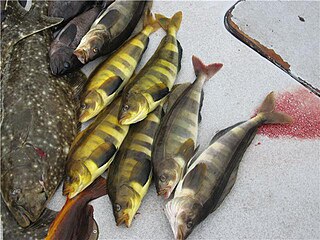
Koi, or more specifically nishikigoi, are colored varieties of carp that are kept for decorative purposes in outdoor koi ponds or water gardens.

A tuna is a saltwater fish that belongs to the tribe Thunnini, a subgrouping of the Scombridae (mackerel) family. The Thunnini comprise 17 species across five genera, the sizes of which vary greatly, ranging from the bullet tuna up to the Atlantic bluefin tuna, which averages 2 m (6.6 ft) and is believed to live up to 50 years.

The largemouth bass is a carnivorous freshwater ray-finned fish in the Centrarchidae (sunfish) family, native to the eastern and central United States, southeastern Canada and northern Mexico. It is known by a variety of regional names, such as the widemouth bass, bigmouth bass, black bass, bucketmouth, largie, Potter's fish, Florida bass, Florida largemouth, green bass, bucketmouth bass, green trout, Gilsdorf bass, Oswego bass, LMB, and southern largemouth and northern largemouth.

The term carp is a generic common name for numerous species of freshwater fish from the family Cyprinidae, a very large clade of ray-finned fish mostly native to Eurasia. While carp are prized quarries and are valued as both food and ornamental fish in many parts of the Old World, they are considered trash fish and invasive pests in many parts of Africa, Australia and most of the United States.

The Philippine Sea is a marginal sea of the Western Pacific Ocean east of the Philippine Archipelago and the largest sea in the world, occupying an estimated surface area of 5 million square kilometers. The Philippine Sea Plate forms the floor of the sea. Its western border is the first island chain to the west, comprising the Ryukyu Islands in the northwest and Taiwan in the west. Its southwestern border comprises the Philippine islands of Luzon, Catanduanes, Samar, Leyte, and Mindanao. Its northern border comprises the Japanese islands of Honshu, Shikoku and Kyūshū. Its eastern border is the second island chain to the east, comprising the Bonin Islands and Iwo Jima in the northeast, the Mariana Islands in the due east, and Halmahera, Palau, Yap and Ulithi in the southeast. Its southern border is Indonesia's Morotai Island.

Semiarundinaria is a genus of East Asian bamboo in the grass family.

The Atlantic bluefin tuna is a species of tuna in the family Scombridae. It is variously known as the northern bluefin tuna, giant bluefin tuna, and formerly as the tunny.

Slickheads, also known as nakedheads or smoothheads, are deep water fishes that belong to the family Alepocephalidae. They are most commonly found in the bathypelagic layer, which is approximately 3000m below the surface. They get their name from the lack of scales on their heads. Similarly, the scientific name is from the Greek ᾰ̓- (a-, "not"); λέπος (lepos, "scale"); and κεφαλή (kephalē, "head"). It has about 22 genera with ca. 96 species.
Shorea leptoderma is a species of plant in the family Dipterocarpaceae. It is a tree endemic to Borneo where it is confined to Sabah. It grows in lowland rain forest.

The Alaska pollock or walleye pollock is a marine fish species of the cod genus Gadus and family Gadidae.

The Atka mackerel is a mackerel in the family Hexagrammidae. Atka mackerel are common in the northern Pacific Ocean, and are one of only two members of the genus Pleurogrammus – the other being the Arabesque greenling. The Atka mackerel was named for Atka Island, the largest island of the Andreanof islands, a branch of the Aleutians.
Pseudospora is a genus of parasitic cercozoans.
Filientomon is a genus of proturans in the family Acerentomidae.
Genetypes is a taxonomic concept proposed in 2010 to describe any genetic sequences from type specimens. This nomenclature integrates molecular systematics and terms used in biological taxonomy. This nomenclature is designed to label, or flag, genetic sequences that were sampled from type specimens. The nomenclature of genetypes proposes that genetic sequences from a holotype should be referred to as a “hologenetype”, sequences from a topotype should be a “topogenetype”, and so forth. In addition, the genetic marker(s) used should be incorporated into the nomenclature.
Leptoderma is a genus of slickheads found in the deep waters of the oceans.
Filientomon lubricum is a species of proturan in the family Acerentomidae. It is found in Southern Asia.
Leptoderma ospesca, the eastern eel-slickhead, is a species of slickhead found in the eastern-central Pacific Ocean.
Leptoderma retropinna is a species of slickhead found in the Indian Ocean.
Leptoderma macrops, the grenadier smooth-head, is a species of slickhead found in the eastern Atlantic Ocean.
Leptoderma macrophthalmum is a species of slickhead found in the Atlantic Ocean.









